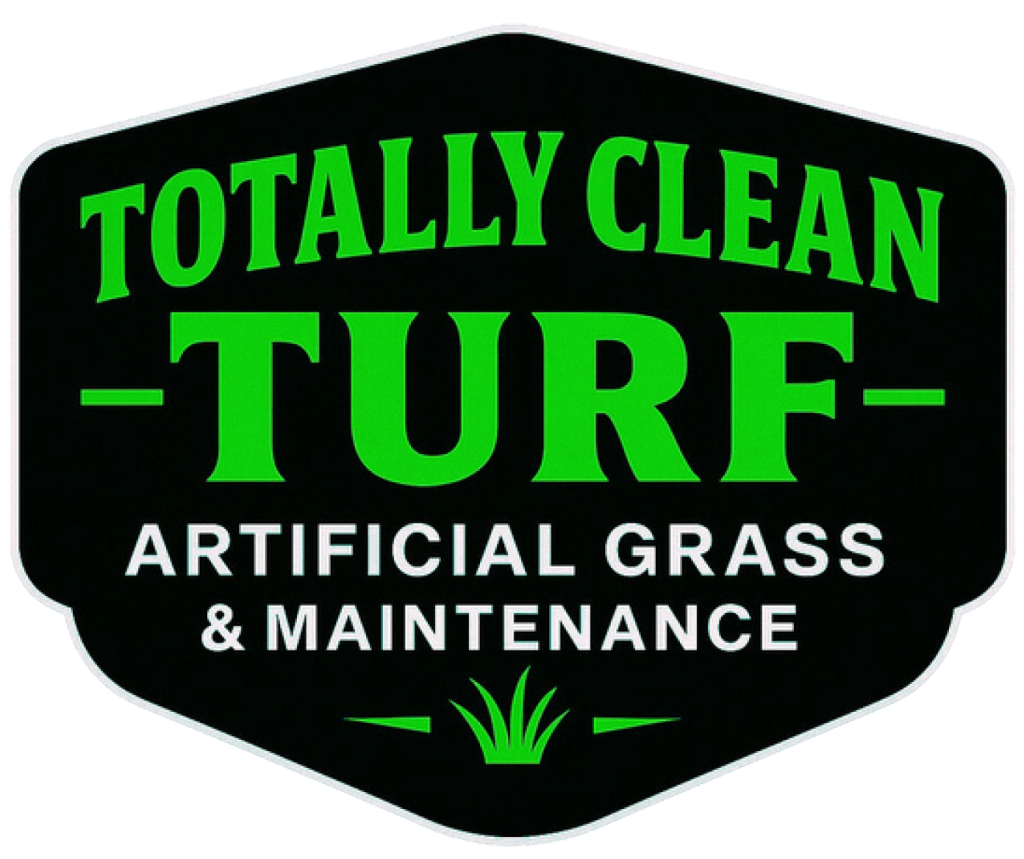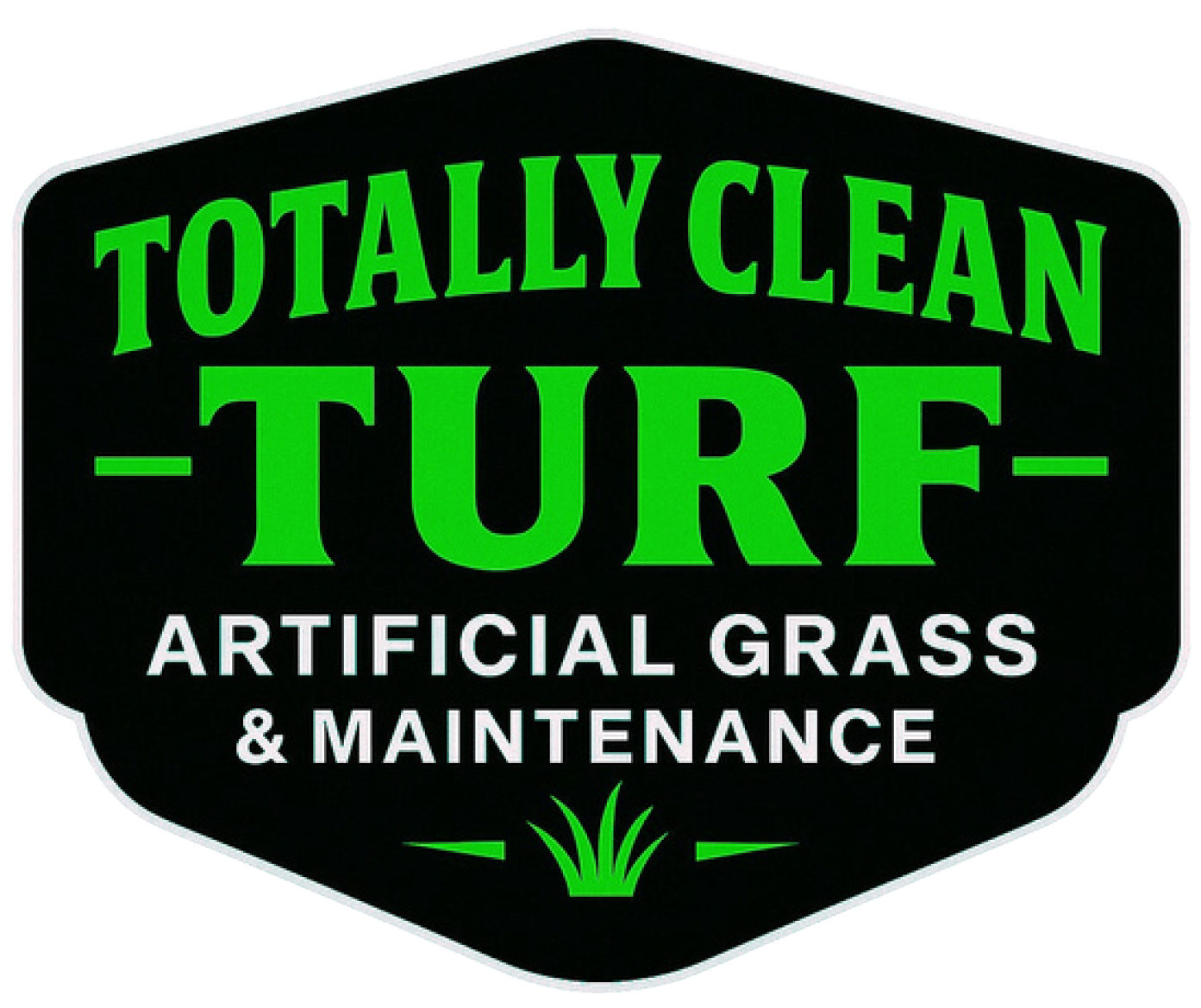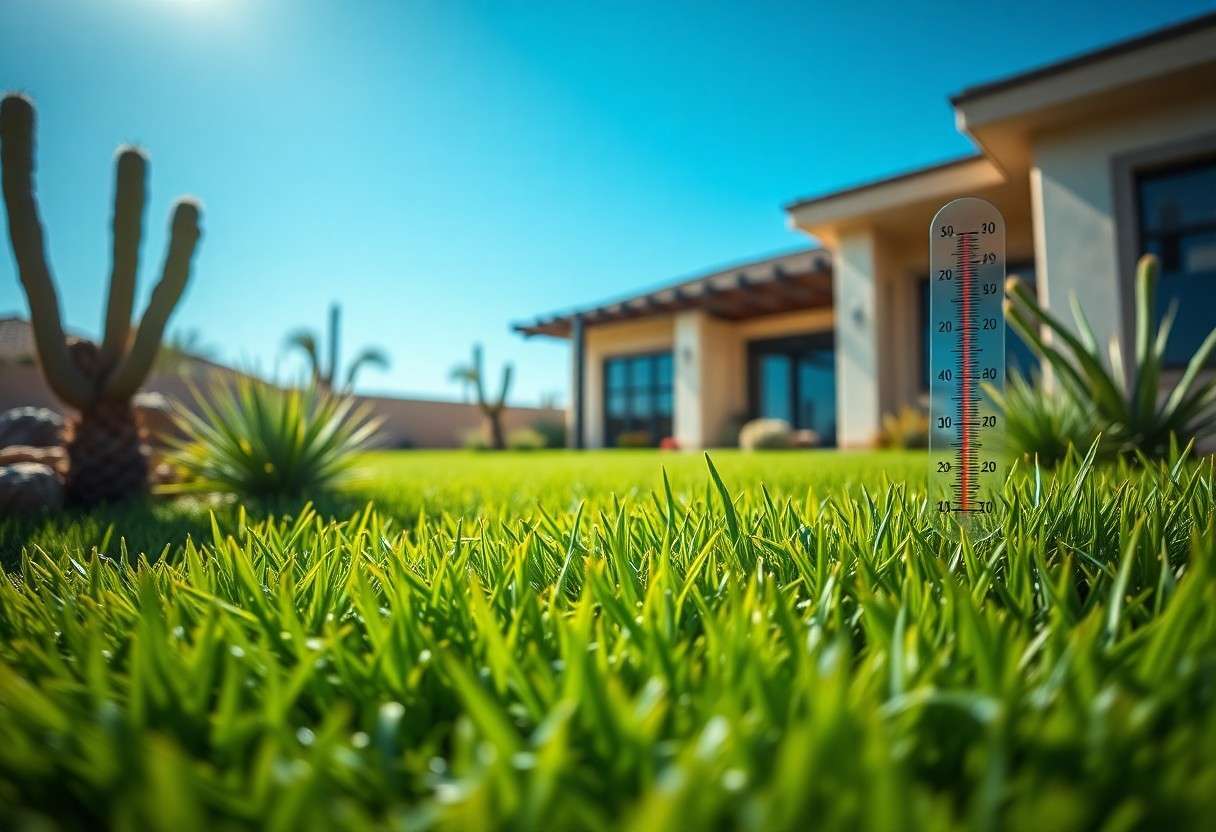With hot climates posing unique challenges for landscaping, choosing the right artificial grass ensures your lawn stays vibrant and comfortable year-round. You need turf designed to withstand high temperatures, resist fading, and maintain softness underfoot. In this guide, you’ll learn what features to prioritize when selecting synthetic grass that performs well in intense heat, helping you create a low-maintenance, water-saving lawn suited to your environment.
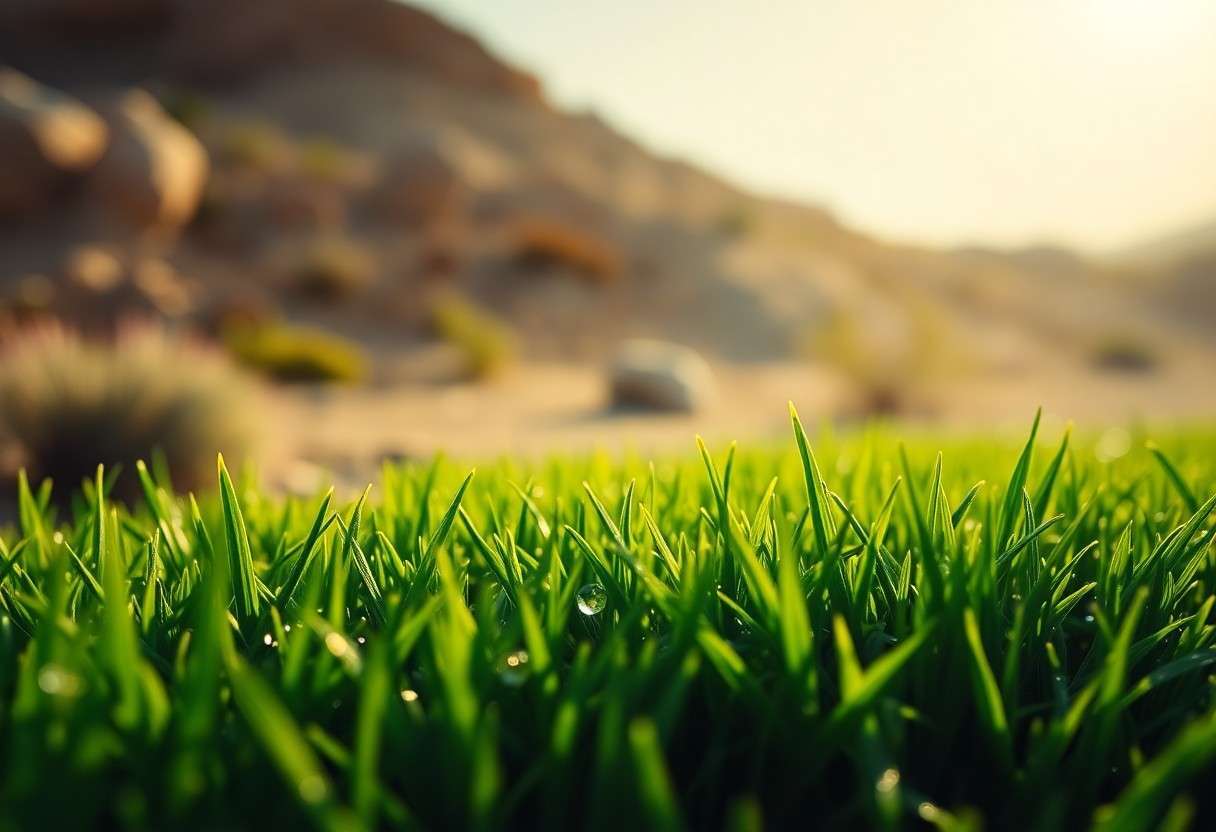
Key Takeaways:
- Choose artificial grass made from UV-resistant materials to prevent fading and degradation under intense sun exposure common in hot climates.
- Opt for turf with good heat dissipation and lower surface temperatures to ensure comfort for bare feet and pets during hot weather.
- Select varieties with durable backing and high-quality fibers that withstand heavy foot traffic and maintain their appearance despite extreme heat.
Climate Challenges for Turf
Hot climates bring unique obstacles to maintaining lush, green turf. Scorching sun, intense UV exposure, and minimal rainfall create stress that wears down natural grass quickly and tests the durability of artificial options. You have to factor in soil dryness, heat retention, and overall landscape adaptability to select the right turf type. Whether for residential lawns, pet zones, or playgrounds, understanding these challenges helps ensure your grass stays vibrant and functional throughout the relentless heat waves common in Southern California’s desert cities.
Extreme Heat Effects on Natural Grass
Natural grass can suffer from dehydration, browning, and root damage during prolonged heat spells exceeding 90°F. The plant’s cellular structure weakens without consistent irrigation, leading to patchy, thin growth that invites weed invasion and erosion. Frequent mowing becomes tougher as the blades dry and dull faster in intense heat. Even drought-resistant grass varieties face challenges maintaining their color and density, pushing many homeowners toward drought-tolerant or synthetic alternatives for reliable curb appeal and usability.
Unique Demands of Hot Weather on Synthetic Options
Synthetic turf faces its own hurdles under high temperatures, such as surface heat buildup that can reach over 140°F in direct sunlight, making it uncomfortable for kids and pets. UV radiation gradually degrades the fibers, diminishing color and flexibility without proper UV stabilizers. Additionally, heat can cause expansion and strain on the infill and backing materials, potentially shortening turf lifespan. Selecting turf designed specifically for high-heat environments and performing regular maintenance like turf decompaction and cooling treatments helps maintain comfort and durability.
Beyond heat buildup concerns, you’ll find that specialized synthetic grasses incorporate cooling technologies, such as coated fibers and permeable infills, that reflect sunlight and improve airflow. These features not only reduce surface temperature by up to 30% compared to traditional turf but also enhance drainage during rare rain events, preventing mold and bacterial growth. Products certified for high UV resistance ensure longer-lasting color retention, important for outdoor pet areas and playgrounds exposed to relentless sun. Partnering with a knowledgeable installer like Totally Clean Turf ensures materials and installation techniques are optimized for these environmental stresses, ensuring your turf investment performs reliably for years.
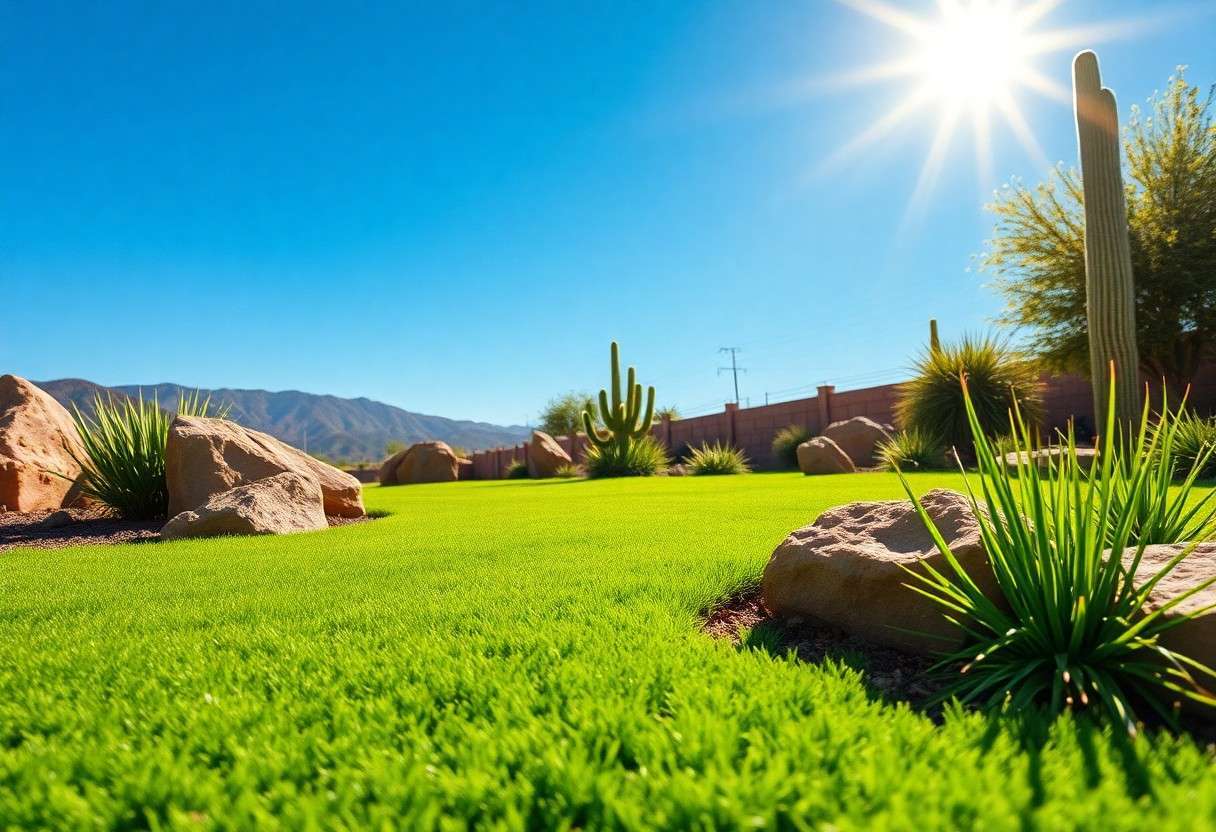
The Best Materials for Heat Resistance
Selecting synthetic fibers with built-in UV stabilization and high thermal tolerance ensures your artificial grass withstands the relentless heat common in Southern California’s desert and inland valleys. Polyethylene fibers dominate as the top choice; they combine softness with durability and superior resistance to color fading. Nylon, while strong, can absorb more heat, making it less ideal for hot climates. You benefit from turf that remains vibrant and resilient, with less risk of brittleness or melting, maintaining a lush look even under direct sun exposure.
Heat-Reflective Technology in Synthetic Turf
Modern artificial grass incorporates heat-reflective additives within the polymer blades to reduce surface temperature by up to 30%. This tech works by reflecting infrared light rather than absorbing it, keeping turf cooler despite intense sunlight. Some premium turf brands use proprietary coatings or lighter blade colors combined with reflective backing materials. You’ll notice the difference when walking barefoot or allowing pets to lounge, as these innovations tackle the common “hot turf” complaint effectively.
The Role of Infill Materials in Temperature Management
Infill materials play a significant part in controlling turf temperature through heat absorption and dissipation properties. Options like silica sand and coated rubber vary widely in thermal behavior; sand typically stays cooler but lacks cushioning, while rubber infill provides softness but can retain more heat. Modern infills infused with cooling minerals or organic materials such as cork and coconut fibers offer balanced comfort with reduced heat retention. Your choice of infill directly influences the overall surface heat, impacting usability for pets and children.
Infill Types and Their Thermal Properties
| Infill Type | Heat Management Characteristics |
|---|---|
| Silica Sand | Low heat retention, good drainage, less cushioning |
| Rubber (SBR or EPDM) | Higher heat retention, excellent cushioning, potential overheating |
| Organic (Cork, Coconut Fiber) | Natural cooling effect, biodegradable, moderate cushioning |
| Coated Infill (Cooling Minerals) | Reflects heat, reduces surface temperature, engineered for comfort |
Choosing the right infill is as impactful as the turf fiber itself in moderating surface heat. Infills like coated minerals or organic blends not only minimize temperature spikes but also improve comfort and safety, particularly in dog runs or playgrounds. Totally Clean Turf customizes infill selection based on your specific climate and usage needs, ensuring a cooler, more enjoyable lawn year-round.
Top Choices for Hot Climates
Choosing artificial grass designed to withstand extreme heat means prioritizing materials that resist fading and retain softness under relentless sun exposure. Products with UV-stabilized polyethylene fibers combined with sturdy backing provide durability and vibrant color longevity. Low-pile grasses allow better airflow and reduce heat retention, while infill options like cooling granules can keep surfaces comfortable for kids and pets. Brands focusing on eco-friendly, water-saving solutions match the needs of hot, arid regions perfectly, delivering landscapes that stay lush without the hassle of constant watering and upkeep.
Overview of Leading Brands and Their Features
Brands such as TigerTurf, SynLawn, and FieldTurf offer specialized turf lines engineered for hot climates. TigerTurf’s SolarMax™ fibers provide enhanced UV protection preventing discoloration, while SynLawn’s CoolGrass® technology lowers surface temperature up to 30 degrees. FieldTurf emphasizes durability with their proprietary Monofilament fiber, offering strong resistance to mats and heat wear. These brands prioritize non-toxic materials, realistic texture, and pet-friendly options, letting you pick turf that balances function, appearance, and climate resilience.
Performance Metrics: Lifespan, Maintenance, and Warranties
Artificial turf designed for hot climates typically carries warranties ranging from 8 to 15 years, with a lifespan that can extend beyond two decades when properly maintained. Maintenance needs include regular turf blooming and decompaction to keep fibers resilient against sun flattening, plus turf sanitizing protocols to handle potential odor buildup from pets. Many manufacturers back their products with UV fade warranties, ensuring color retention even after prolonged sun exposure, providing peace of mind alongside low-maintenance appeal.
Looking deeper, warranties often cover fiber degradation and backing integrity but check specifics on UV resistance since exposure to intense sunlight can accelerate wear. Maintenance intervals vary: decompaction might be required biannually in high-traffic pet areas while odor removal treatments can be scheduled quarterly for busy households. Incorporating turf blooming revitalizes flattened fibers that can stiffen under heat, maintaining a plush, natural look year-round. This layered maintenance approach, combined with robust manufacturer support, extends turf life and enhances your investment in sustainable, low-maintenance landscaping.
Installation Considerations for Optimal Performance
Proper installation significantly affects how well your artificial grass performs in hot climates. Selecting materials and methods that maximize drainage, reduce heat retention, and accommodate local soil conditions ensures a lush, cool turf surface. Attention to detail during the installation phase helps prevent issues like turf degradation, odor buildup, or excessive heat absorption, so your synthetic lawn remains durable and comfortable under the sun year-round.
Choosing the Right Base Layer for Drainage and Cooling
Opt for a base layer with high permeability, such as crushed rock or decomposed granite, to promote rapid drainage and avoid water pooling. This layer not only prevents soggy patches but also aids in dissipating heat trapped beneath the turf. Incorporating a well-graded base reduces compaction over time and maintains a firm yet cushioned surface, enhancing your lawn’s longevity and keeping temperatures more manageable during scorching days.
Expert Tips for Proper Installation in Hot Conditions
Installing artificial grass in hot climates requires specific tactics to optimize comfort and durability. Use lighter-colored turf fibers that reflect sunlight, minimizing heat absorption. Stretch and secure the turf tightly to avoid wrinkles that trap heat or retain dirt. Adequate infill with cooling granules or silica sand supports fiber uprightness and temp regulation. Regular turf decompaction and blooming maintain plushness, especially in pet or play areas. Recognizing these installation details helps you enjoy a cooler, longer-lasting lawn despite intense sun exposure.
Additional insights reinforce how expert installation adapts to hot environments. Installing during cooler parts of the day reduces material stress and improves adhesion for seam tapes and glues. UV-resistant adhesives and fibers are vital to combat sun damage over years. Employing infill mixes that integrate nylon or thermoplastic elastomer granules can notably lower surface temperatures by 10-15°F compared to traditional crumb rubber. Periodic turf maintenance, such as decompaction and blooming, revitalizes the grass’s natural look and heat resistance. Recognizing these industry-leading methods positions your synthetic lawn for optimal performance even in extreme heat.
- Schedule installation during early mornings or late afternoons to minimize material expansion and ensure precise seaming.
- Select UV-stabilized fibers to maintain color and integrity under constant sun exposure.
- Infill choice matters: cooling infills reduce radiant heat buildup versus standard crumb rubber.
- Maintain your turf regularly with professional turf decompaction and blooming services to preserve softness and appearance.
- Recognizing these installation and maintenance best practices extends the life and comfort of your turf in hot climates.
Maintenance Tips for Longevity in Warm Areas
Keeping artificial grass vibrant under intense heat requires regular upkeep. Focus on routine debris removal to prevent buildup that traps heat and inhibits drainage. Employ turf decompaction in high-traffic zones to maintain softness and airflow beneath the blades. Use turf blooming techniques to raise flattened fibers, preserving that fresh, plush appearance. Regular odor removal treatments efficiently neutralize pet smells that heat can intensify. Perceiving these actions as important elements of your turf care routine will extend its lifespan and maintain a cool, inviting surface throughout hot seasons.
Seasonal Care Routines
Warmer months demand increased watering of the turf infill to cool the surface and minimize heat retention. In spring and fall, deep cleaning and turf sanitizing help tackle accumulated microbes and allergens, particularly after winter rains. Scorching summers may require more frequent odor removal to combat intensified pet odors and organic decay. You’ll find quarterly maintenance schedules streamline this process and keep your artificial grass looking consistently lush and safe for family and pets.
Addressing Odor and Turf Damage from Heat
Exposure to high temperatures accelerates organic buildup and pet waste odors if not promptly addressed. Applying specialized turf cleaning solutions prevents persistent smells and inhibits material breakdown caused by heat stress. You can also schedule regular treatments that sanitize and rejuvenate fibers, preventing deterioration from sun exposure and heavy use.
Prolonged heat can toughen odors and weaken the turf’s backing, especially in pet zones and playground areas. Utilizing Turf Blooming restores fibers compressed by heat and foot traffic, improving appearance and longevity. Odor removal treatments with enzymatic cleaners break down waste particles before heat amplifies the smell. Maintaining this regimen prevents costly damage and keeps the environment safe for children and pets. Incorporating professional turf decompaction and sanitizing enhances drainage and inhibits microbial growth aggravated by warm climates.
To wrap up
To wrap up, when choosing the best artificial grass for hot climates, you want a product designed to withstand intense sun and high temperatures without fading or becoming overly hot to the touch. Look for turf with UV protection, breathable backing, and heat-reflective fibers to ensure durability and comfort. Your ideal choice should also offer low maintenance and water-saving benefits, making it perfect for creating a beautiful, long-lasting lawn that stays lush even under the hottest conditions.
FAQ
Q: What type of artificial grass performs best in hot climates?
A: In hot climates, artificial grass made from polyethylene fibers is generally the best choice. Polyethylene is soft, durable, and has excellent UV resistance, which helps prevent fading and degradation from prolonged sun exposure. Additionally, looking for turf with built-in cooling technology or that includes heat-reflective backing can help reduce surface temperatures, making your lawn more comfortable underfoot.
Q: How can I ensure my artificial grass stays cool during intense heat?
A: Proper installation and turf selection both play a role in maintaining cooler artificial grass in hot weather. Using infill materials such as specialized cooling sand or crumb rubber can help regulate temperature. Also, choosing lighter (natural green) turf colors instead of darker shades can reduce heat absorption. Regular maintenance, such as rinsing the turf with water during hot periods, can further help lower the surface temperature.
Q: Is artificial grass a good option for pet areas in hot climates?
A: Yes, artificial grass is a great solution for pet areas in hot climates, especially when you select turf designed for pets with effective turf sanitizing and odor removal properties. Look for turf products that offer high durability and UV resistance to withstand sun exposure and pet activity. Combining this with professional turf maintenance services, like odor removal and sanitizing, helps keep pet zones clean, safe, and comfortable even during hot weather.
